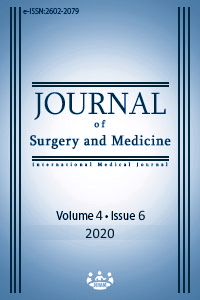The utility of mean platelet volume as a predictor of postoperative atrial fibrillation following coronary artery bypass grafting
Keywords:
Postoperative atrial fibrillation, Mean platelet volume, Coronary artery bypass grafting, Biochemical parametersAbstract
Downloads
References
Maisel WH, Rawn JD, Stevenson WG. Atrial fibrillation after cardiac surgery. Ann Intern Med. 2001;135:1061-73.
Erdem K, Ayhan S, Ozturk S, Bugra O, Bozoglan O, Dursin H, et al. Usefulness of the mean platelet volume for predicting new-onset atrial fibrillation after isolated coronary artery bypass grafting. Platelets. 2014;25:23-6.
Yuksel A, Velioglu Y, Tecimer ME, Kan II, Bicer M, Gurbuz O, et al. Is there any relationship of postoperative atrial fibrillation with the use of blood products and postoperative hemoglobin levels in patients undergoing coronary artery bypass grafting? Medicine Science. 2019;8:16-20.
Velioglu Y, Yuksel A. Predictors of postoperative atrial fibrillation after beating-heart coronary artery bypass surgery: is cardiopulmonary bypass a risk factor? Acta Cardiol Sin. 2019;35:468-75.
Yadava M, Hughey AB, Crawford TC. Postoperative atrial fibrillation: incidence, mechanisms, and clinical correlates. Heart Fail Clin. 2016;12:299-308.
Mariscalco G, Engström KG, Ferrarese S, Cozzi G, Bruno VD, Sessa F, et al. Relationship between atrial histopathology and atrial fibrillation after coronary bypass surgery. J Thorac Cardiovasc Surg. 2006;131:1364-72.
Mathew JP, Fontes ML, Tudor IC, Ramsay J, Duke P, Mazer CD, et al. A multicenter risk index for atrial fibrillation after cardiac surgery. JAMA. 2004;291:1720-9.
Banach M, Rysz J, Drozdz JA, Okonski P, Misztal M, Barylski M, et al. Risk factors of atrial fibrillation following coronary artery bypass grafting: a preliminary report. Circ J. 2006;70:438-41.
Gasparyan AY, Ayvazyan L, Mikhailidis DP, Kitas GD. Mean platelet volume: A link between thrombosis and inflammation? Curr Pharm Des. 2011;17:47-58.
Krashin E, Cohen O, Pereg D, Lishner M, Leader A. Mean platelet volume and risk of thrombotic and bleeding complications in patients with Philadelphia chromosome negative myeloproliferative neoplasms. Blood Coagul Fibrinolysis. 2018;29:288-93.
Tang WB, Li MX, Li GQ, Cai JD, Wei S, Wan YB. Changes of Mean Platelet Volume, Fibrinogen Content and Blood Rheology in Peripheral Blood of Youth Patients With Cerebral Infarction. Zhongguo Shi Yan Xue Ye Xue Za Zhi. 2012;20:390-3.
Murat SN, Duran M, Kalay N, Gunebakmaz O, Akpek M, Doger C, et al. Relation Between Mean Platelet Volume and Severity of Atherosclerosis in Patients With Acute Coronary Syndromes. Angiology. 2013;64:131-6.
Azab B, Zaher M, Weiserbs KF, Torbey E, Lacossiere K, Gaddam S, et al. Usefulness of neutrophil to lymphocyte ratio in predicting short- and long-term mortality after non ST-elevation myocardial infarction. Am J Cardiol. 2010;106:470-6.
Bas HA, Bagci A, Aksoy F. Usefulness of Mean Platelet Volume and Neutrophil-To-Lymphocyte Ratio for Development of Atrial Fibrillation After Acute Myocardial Infarction. Süleyman Demirel Üniversitesi Sağlık Bilimleri Dergisi. 2019;10:278-83.
Abeer AT, Effat AE, Wafaa SM, Emad FK. The Predictive Effect of Mean Platelet Volume (MPV) and Neutrophil-to-Lymphocyte Ratio (NLR) on the Functional Outcome of Acute Ischemic Stroke. Med J Cairo Univ. 2018;86:4107-13.
Deif RHEE, El-sheikh RG, El-Sokary HM. Relation between Mean Platelet Volume and Supraventricular Tachyarrhythmias. Nature and Science 2019;17(12).
Altun İ, Akın F, Biteker M, Köse N, Güz G, Öz F, et al. Mean Platelet Volume in Patients with Arrhythmogenic Right Ventricular Cardiomyopathy/Dysplasia. Med Bull Haseki. 2015;53:303-7.
Degerli V, Ergin I, Duran FY, Ustuner MA, Duran O. Could Mean Platelet Volume Be a Reliable Indicator for Acute Mesenteric Ischemia Diagnosis? A Case-Control Study. Biomed Res Int. 2016;2016:9810280. doi:10.1155/2016/9810280.
Feng C, Mei W, Luo C, Long M, Hu X, Huang Y, et al. Relationship between mean platelet volume and coronary blood flow in patients with atrial fibrillation. Heart Lung Circ. 2013;22:43‐9.
Gawlita M, Wasilewski J, Osadnik T, Reguła R, Bujak K, Gonera M. Mean platelet volume and platelet-large cell ratio as prognostic factors for coronary artery disease and myocardial infarction. Folia Cardiologica. 2015;10:418-22.
Ghahremanfard F, Asghari N, Ghorbani R, Samaei A, Ghomi H, Tamadon M. The relationship between mean platelet volume and severity of acute ischemic brain stroke. Neurosciences (Riyadh). 2013;18:147-51.
Bath P, Algert C, Chapman N, Neal B, PROGRESS Collaborative Group. Association of mean platelet volume with risk of stroke among 3134 individuals with history of cerebrovascular disease. Stroke. 2004;35:622-6.
Demir ÜF. Mean Platelet Volume Values and Its Effects on Prognosis in Patients with Acute Ischemic Stroke. Bagcilar Med Bull. 2019;4:99-105.
Chung I, Choudhury A, Patel J, Lip GY. Soluble CD40L, platelet surface CD40L and total platelet CD40L in congestive heart failure: relationship to platelet volume, mass and granularity. J Intern Med. 2008;263:313-21.
Hasan MA, Milon MK, Kashem MA, Karim MR. Effects of Preoperative Mean Platelet Volume on Early Outcomes of Patients After Conventional Coronary Artery Bypass Graft Surgery. University Heart Journal. 2018;14:24-7.
Icli A, Aksoy F, Dogan A, Arslan A, Ersoy I, Yucel H, et al. Mean platelet volume may be elevated in mitral valve prolapse and associated with the severity of prolapse. Clin Appl Thromb Hemost. 2013;19:608-12.
Boos CJ, Lip GY. Assessment of mean platelet volume in coronary artery disease - what does it mean? Thromb Res. 2007;120:11-3.
Velioglu Y, Yuksel A. Complete blood count parameters in peripheral arterial disease. Aging Male. 2019;22:187-91.
Korniluk A, Koper-Lenkiewicz OM, Kamińska J, Kemona H, Dymicka-Piekarska V. Mean Platelet Volume (MPV): New Perspectives for an Old Marker in the Course and Prognosis of Inflammatory Conditions. Mediators Inflamm. 2019;2019:9213074. doi:10.1155/2019/9213074
Velioglu Y, Yuksel A. Utility of platelet-to-lymphocyte ratio to support the diagnosis of acute deep vein thrombosis. Turk Gogus Kalp Damar Cerrahisi Derg. 2019;27:493-8.
van der Planken MG, Vertessen FJ, Vertommen J, Engelen W, Berneman ZN, De Leeuw I. Platelet prothrombinase activity, a final pathway platelet procoagulant activity, is overexpressed in type 1 diabetes: no relationship with mean platelet volume or background retinopathy. Clin Appl Thromb Hemost. 2000;6:65-8.
Weymann A, Ali-Hasan-Al-Saegh S, Popov AF, Sabashnikov A, Mirhosseini SJ, Liu T, et al. Haematological indices as predictors of atrial fibrillation following isolated coronary artery bypass grafting, valvular surgery, or combined procedures: a systematic review with meta-analysis. Kardiol Pol. 2018;76:107-18.
Downloads
- 543 1041
Published
Issue
Section
How to Cite
License
Copyright (c) 2020 Mustafa Çağdaş Çayır
This work is licensed under a Creative Commons Attribution-NonCommercial-NoDerivatives 4.0 International License.
















